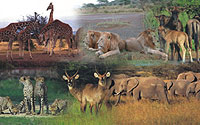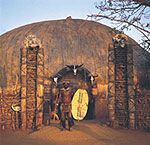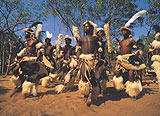|
Salaam
Dar!...
|
|
|
If you wanted to experiment with local cuisine comprising the down-to-earth nyama choma and chakula or the nguli, then Rose Garden was the place. A quiet stroll away from our house, it was a simple garden restaurant with outdoor plastic furniture, and plenty of mosquito repellants burning under the tables. The service was frustrating but I have seen many smiling faces at the end of a wholesome meal.
We had serious communication issues. The only English our local domestic help Witness, or Whitney as we called her, knew was the word ‘yes’ said with a nod and a blink in slow motion. My attempts at Swahili straight off a guide were received with giggles and we usually got nowhere.
The hot spots in and around Dar were many and we had precious few days to indulge and soak in the sun. Nevertheless, a beautiful drive to the White Sands was like a drive through Goa, Kerala, Africa, and the Mediterranean all rolled into one. And of course the African spirit showed up on the sands when hundreds of vigorous young men hurled themselves into the ocean, disrupted the peace of a private beach, and got into a fight with the cops, who had to resort to opening fire to scatter them away.
|
|

|
|
TANZANIA: A land where wilderness beckons |
|
|
Unimaginable. And later some thoughtful soul herded in a drove of cattle obviously having decided his animals needed a day out. So we hung around, read dog-eared books and slept the afternoon away.
I once had the opportunity of attending a breakfast for expatriate women in Dar. The social event had a wonderful fall out. One of the women (in charge of updates on events and happenings) mentioned this marvelous train safari that her family had discovered and was extremely inspiring.
A train safari. (Hmmm).
Trains are commonplace to us Indians. Safaris are not. But a combination of a safari in a train sounded almost surreal. A South African couple had started a unique and luxurious train journey through the heart of Selous 1, a game reserve more than 50,000 sq km, located in the south eastern part of Tanzania. It boasted of the world’s greatest remaining herds of the buffalo, elephant, hippo, and the sable antelope.
The Tazara Station where we boarded was, to put it mildly, completely devoid of any form of activity or life. No one seemed to be traveling anywhere from this uninhabited railway station and it was a bit unnerving. Finally, our fellow passengers seemed to arrive in bits and pieces, and the charming steam engine screeched and shunted. By 9 am the door to the single carriage was opened and we were quite unprepared for the sheer extravagance and comfort awaiting us. For those who have seen documentaries or have been lucky to have actually experienced our very own Palace on Wheels, this was similar in
flavour. It was completely refurbished to enhance that ‘old style’ travel and we sank into opulent couches, happily soaked in the extraordinary atmosphere, eyed our fellow passengers with unconcealed curiosity, and refreshed ourselves with hot coffee and sandwiches.
The journey was the destination.
The first hour sped by amid country landscape and we watched scenes that are so reminiscent of the great Indian countryside. Banana plantations, tiny huts, brown kids waving from remote villages. The transition to bush land went almost unnoticed. We realised the change when one of the passengers who was a local guide of sorts, was suddenly pointing excitedly to blurs of brown in the savannah and yelling animatedly.
There they were. Beautiful creatures that made our skin tingle in amazement.
The sight of tall, graceful giraffes running along the train, zebras staring in indifference, warthogs dashing across bushes, and those magnificent African elephants fanning their expansive ears created a sense of awe, a deep respect for nature, and gratitude for being a part of it. We craved for more such sights. Craning to get a glimpse before the animals disappeared, withdrawing our heads with sore necks and wind-swept hair. We captured still life on digital medium and hoped that those images would help jostle our memories years later.
|
 |
 |
|
ARMED: A Zulu warrior shows off his wares |
CHARMED: Zulus perform a war dance |
|
|
A holiday in Dar would be incomplete without a sojourn to Zanzibar. This spice island lies off the coast of Tanzania in the Indian Ocean, and was once a bustling commercial hub for the first Arab traders in the 8th century.
The obvious way to travel to Zanzibar is by sea. Ferries from Dar leave by the hour with hundreds of tourists, traders, pseudo-natives visiting ancient family homes with few surviving relatives. I was completely sea-sick and tried to be as nonchalant as my queasy stomach would allow. The view was breath-taking and we spent the hour-long journey making frequent trips to the hull watching churning white foam, the cafeteria for coffee refills, and to the upper deck for some sunlit photography.
The Zanzibar Beach Resort was a quaint hideout, with all the trappings of a modern luxury hotel. The famous Zanzibari carved and embellished, four-post bed with its silk canopy, the laid back comfort of hotel service, and those lavish buffets were the main attractions of a rainy holiday. Zanzibar is very like coastal India and what makes it somewhat different are the ancient Stone Town and its spice gardens. We were unfortunate to not get a pungent whiff of cardamoms and pepper owing to the rain, but Stone Town was definitely on the agenda. The cultural heart of Zanzibar we were told, retained most of its 200-year-old charm, with indignation and pride. Today, Stone Town has been declared a World Heritage Site by UNESCO.
It is a maze of narrow streets and cobbled paths, rows of poky shops crammed with artifacts and paintings, with owners vying with each other for a larger chunk of tourist money. Most houses were in a state of disrepair in the old city, with remnants of brass-studded, carved wooden doors reminding you of what must have been a time of bustling bazaars and grand Arab houses. At the centre of Stone Town was the beautiful amphitheatre made entirely of stone.
The dark continent is the worst misnomer in the history of the world. There is nothing remotely dark about Africa, and what little I saw of it.
Ahsante sana Africa. Thank you for happening to me. |
|
|
|
|
|
April 2006
|
|

|
|
|
|